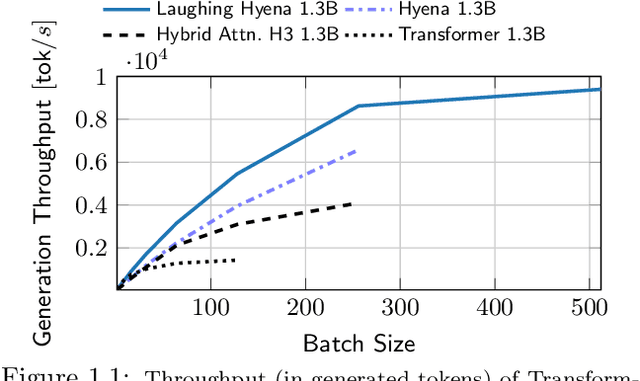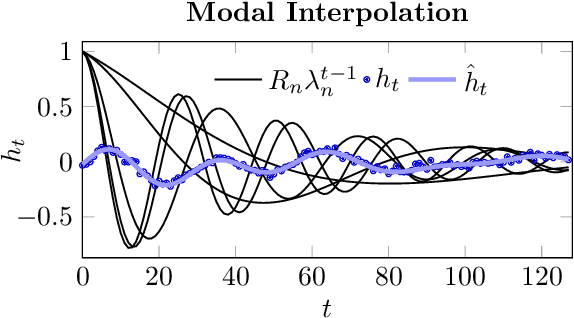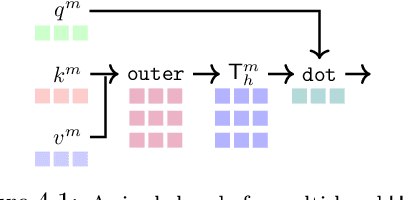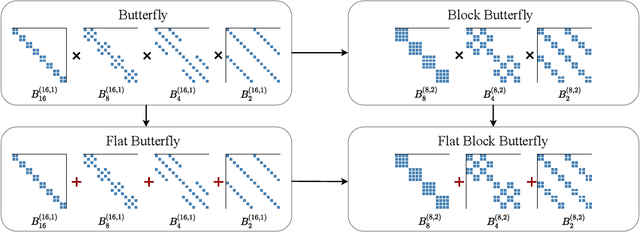Christopher Re
Cartridges: Lightweight and general-purpose long context representations via self-study
Jun 06, 2025Abstract:Large language models are often used to answer queries grounded in large text corpora (e.g. codebases, legal documents, or chat histories) by placing the entire corpus in the context window and leveraging in-context learning (ICL). Although current models support contexts of 100K-1M tokens, this setup is costly to serve because the memory consumption of the KV cache scales with input length. We explore an alternative: training a smaller KV cache offline on each corpus. At inference time, we load this trained KV cache, which we call a Cartridge, and decode a response. Critically, the cost of training a Cartridge can be amortized across all the queries referencing the same corpus. However, we find that the naive approach of training the Cartridge with next-token prediction on the corpus is not competitive with ICL. Instead, we propose self-study, a training recipe in which we generate synthetic conversations about the corpus and train the Cartridge with a context-distillation objective. We find that Cartridges trained with self-study replicate the functionality of ICL, while being significantly cheaper to serve. On challenging long-context benchmarks, Cartridges trained with self-study match ICL performance while using 38.6x less memory and enabling 26.4x higher throughput. Self-study also extends the model's effective context length (e.g. from 128k to 484k tokens on MTOB) and surprisingly, leads to Cartridges that can be composed at inference time without retraining.
Minions: Cost-efficient Collaboration Between On-device and Cloud Language Models
Feb 21, 2025Abstract:We investigate an emerging setup in which a small, on-device language model (LM) with access to local data communicates with a frontier, cloud-hosted LM to solve real-world tasks involving financial, medical, and scientific reasoning over long documents. Can a local-remote collaboration reduce cloud inference costs while preserving quality? First, we consider a naive collaboration protocol where the local and remote models simply chat back and forth. Because only the local model reads the full context, this protocol achieves a 30.4x reduction in remote costs, but recovers only 87% of the performance of the frontier model. We identify two key limitations of this protocol: the local model struggles to (1) follow the remote model's multi-step instructions and (2) reason over long contexts. Motivated by these observations, we study an extension of this protocol, coined MinionS, in which the remote model decomposes the task into easier subtasks over shorter chunks of the document, that are executed locally in parallel. MinionS reduces costs by 5.7x on average while recovering 97.9% of the performance of the remote model alone. Our analysis reveals several key design choices that influence the trade-off between cost and performance in local-remote systems.
Do Multimodal Foundation Models Understand Enterprise Workflows? A Benchmark for Business Process Management Tasks
Jun 19, 2024



Abstract:Existing ML benchmarks lack the depth and diversity of annotations needed for evaluating models on business process management (BPM) tasks. BPM is the practice of documenting, measuring, improving, and automating enterprise workflows. However, research has focused almost exclusively on one task - full end-to-end automation using agents based on multimodal foundation models (FMs) like GPT-4. This focus on automation ignores the reality of how most BPM tools are applied today - simply documenting the relevant workflow takes 60% of the time of the typical process optimization project. To address this gap we present WONDERBREAD, the first benchmark for evaluating multimodal FMs on BPM tasks beyond automation. Our contributions are: (1) a dataset containing 2928 documented workflow demonstrations; (2) 6 novel BPM tasks sourced from real-world applications ranging from workflow documentation to knowledge transfer to process improvement; and (3) an automated evaluation harness. Our benchmark shows that while state-of-the-art FMs can automatically generate documentation (e.g. recalling 88% of the steps taken in a video demonstration of a workflow), they struggle to re-apply that knowledge towards finer-grained validation of workflow completion (F1 < 0.3). We hope WONDERBREAD encourages the development of more "human-centered" AI tooling for enterprise applications and furthers the exploration of multimodal FMs for the broader universe of BPM tasks. We publish our dataset and experiments here: https://github.com/HazyResearch/wonderbread
Automating the Enterprise with Foundation Models
May 03, 2024Abstract:Automating enterprise workflows could unlock $4 trillion/year in productivity gains. Despite being of interest to the data management community for decades, the ultimate vision of end-to-end workflow automation has remained elusive. Current solutions rely on process mining and robotic process automation (RPA), in which a bot is hard-coded to follow a set of predefined rules for completing a workflow. Through case studies of a hospital and large B2B enterprise, we find that the adoption of RPA has been inhibited by high set-up costs (12-18 months), unreliable execution (60% initial accuracy), and burdensome maintenance (requiring multiple FTEs). Multimodal foundation models (FMs) such as GPT-4 offer a promising new approach for end-to-end workflow automation given their generalized reasoning and planning abilities. To study these capabilities we propose ECLAIR, a system to automate enterprise workflows with minimal human supervision. We conduct initial experiments showing that multimodal FMs can address the limitations of traditional RPA with (1) near-human-level understanding of workflows (93% accuracy on a workflow understanding task) and (2) instant set-up with minimal technical barrier (based solely on a natural language description of a workflow, ECLAIR achieves end-to-end completion rates of 40%). We identify human-AI collaboration, validation, and self-improvement as open challenges, and suggest ways they can be solved with data management techniques. Code is available at: https://github.com/HazyResearch/eclair-agents
Laughing Hyena Distillery: Extracting Compact Recurrences From Convolutions
Oct 28, 2023



Abstract:Recent advances in attention-free sequence models rely on convolutions as alternatives to the attention operator at the core of Transformers. In particular, long convolution sequence models have achieved state-of-the-art performance in many domains, but incur a significant cost during auto-regressive inference workloads -- naively requiring a full pass (or caching of activations) over the input sequence for each generated token -- similarly to attention-based models. In this paper, we seek to enable $\mathcal O(1)$ compute and memory cost per token in any pre-trained long convolution architecture to reduce memory footprint and increase throughput during generation. Concretely, our methods consist in extracting low-dimensional linear state-space models from each convolution layer, building upon rational interpolation and model-order reduction techniques. We further introduce architectural improvements to convolution-based layers such as Hyena: by weight-tying the filters across channels into heads, we achieve higher pre-training quality and reduce the number of filters to be distilled. The resulting model achieves 10x higher throughput than Transformers and 1.5x higher than Hyena at 1.3B parameters, without any loss in quality after distillation.
Deja Vu: Contextual Sparsity for Efficient LLMs at Inference Time
Oct 26, 2023Abstract:Large language models (LLMs) with hundreds of billions of parameters have sparked a new wave of exciting AI applications. However, they are computationally expensive at inference time. Sparsity is a natural approach to reduce this cost, but existing methods either require costly retraining, have to forgo LLM's in-context learning ability, or do not yield wall-clock time speedup on modern hardware. We hypothesize that contextual sparsity, which are small, input-dependent sets of attention heads and MLP parameters that yield approximately the same output as the dense model for a given input, can address these issues. We show that contextual sparsity exists, that it can be accurately predicted, and that we can exploit it to speed up LLM inference in wall-clock time without compromising LLM's quality or in-context learning ability. Based on these insights, we propose DejaVu, a system that uses a low-cost algorithm to predict contextual sparsity on the fly given inputs to each layer, along with an asynchronous and hardware-aware implementation that speeds up LLM inference. We validate that DejaVu can reduce the inference latency of OPT-175B by over 2X compared to the state-of-the-art FasterTransformer, and over 6X compared to the widely used Hugging Face implementation, without compromising model quality. The code is available at https://github.com/FMInference/DejaVu.
Fine-tuning Language Models over Slow Networks using Activation Compression with Guarantees
Jun 02, 2022



Abstract:Communication compression is a crucial technique for modern distributed learning systems to alleviate their communication bottlenecks over slower networks. Despite recent intensive studies of gradient compression for data parallel-style training, compressing the activations for models trained with pipeline parallelism is still an open problem. In this paper, we propose AC-SGD, a novel activation compression algorithm for communication-efficient pipeline parallelism training over slow networks. Different from previous efforts in activation compression, instead of compressing activation values directly, AC-SGD compresses the changes of the activations. This allows us to show, to the best of our knowledge for the first time, that one can still achieve $O(1/\sqrt{T})$ convergence rate for non-convex objectives under activation compression, without making assumptions on gradient unbiasedness that do not hold for deep learning models with non-linear activation functions.We then show that AC-SGD can be optimized and implemented efficiently, without additional end-to-end runtime overhead.We evaluated AC-SGD to fine-tune language models with up to 1.5 billion parameters, compressing activations to 2-4 bits.AC-SGD provides up to 4.3X end-to-end speed-up in slower networks, without sacrificing model quality. Moreover, we also show that AC-SGD can be combined with state-of-the-art gradient compression algorithms to enable "end-to-end communication compression: All communications between machines, including model gradients, forward activations, and backward gradients are compressed into lower precision.This provides up to 4.9X end-to-end speed-up, without sacrificing model quality.
Decentralized Training of Foundation Models in Heterogeneous Environments
Jun 02, 2022



Abstract:Training foundation models, such as GPT-3 and PaLM, can be extremely expensive, often involving tens of thousands of GPUs running continuously for months. These models are typically trained in specialized clusters featuring fast, homogeneous interconnects and using carefully designed software systems that support both data parallelism and model/pipeline parallelism. Such dedicated clusters can be costly and difficult to obtain. Can we instead leverage the much greater amount of decentralized, heterogeneous, and lower-bandwidth interconnected compute? Previous works examining the heterogeneous, decentralized setting focus on relatively small models that can be trained in a purely data parallel manner. State-of-the-art schemes for model parallel foundation model training, such as Megatron, only consider the homogeneous data center setting. In this paper, we present the first study of training large foundation models with model parallelism in a decentralized regime over a heterogeneous network. Our key technical contribution is a scheduling algorithm that allocates different computational "tasklets" in the training of foundation models to a group of decentralized GPU devices connected by a slow heterogeneous network. We provide a formal cost model and further propose an efficient evolutionary algorithm to find the optimal allocation strategy. We conduct extensive experiments that represent different scenarios for learning over geo-distributed devices simulated using real-world network measurements. In the most extreme case, across 8 different cities spanning 3 continents, our approach is 4.8X faster than prior state-of-the-art training systems (Megatron).
Pixelated Butterfly: Simple and Efficient Sparse training for Neural Network Models
Nov 30, 2021



Abstract:Overparameterized neural networks generalize well but are expensive to train. Ideally, one would like to reduce their computational cost while retaining their generalization benefits. Sparse model training is a simple and promising approach to achieve this, but there remain challenges as existing methods struggle with accuracy loss, slow training runtime, or difficulty in sparsifying all model components. The core problem is that searching for a sparsity mask over a discrete set of sparse matrices is difficult and expensive. To address this, our main insight is to optimize over a continuous superset of sparse matrices with a fixed structure known as products of butterfly matrices. As butterfly matrices are not hardware efficient, we propose simple variants of butterfly (block and flat) to take advantage of modern hardware. Our method (Pixelated Butterfly) uses a simple fixed sparsity pattern based on flat block butterfly and low-rank matrices to sparsify most network layers (e.g., attention, MLP). We empirically validate that Pixelated Butterfly is 3x faster than butterfly and speeds up training to achieve favorable accuracy--efficiency tradeoffs. On the ImageNet classification and WikiText-103 language modeling tasks, our sparse models train up to 2.5x faster than the dense MLP-Mixer, Vision Transformer, and GPT-2 medium with no drop in accuracy.
Metadata Shaping: Natural Language Annotations for the Tail
Oct 16, 2021



Abstract:Language models (LMs) have made remarkable progress, but still struggle to generalize beyond the training data to rare linguistic patterns. Since rare entities and facts are prevalent in the queries users submit to popular applications such as search and personal assistant systems, improving the ability of LMs to reliably capture knowledge over rare entities is a pressing challenge studied in significant prior work. Noticing that existing approaches primarily modify the LM architecture or introduce auxiliary objectives to inject useful entity knowledge, we ask to what extent we could match the quality of these architectures using a base LM architecture, and only changing the data? We propose metadata shaping, a method in which readily available metadata, such as entity descriptions and categorical tags, are appended to examples based on information theoretic metrics. Intuitively, if metadata corresponding to popular entities overlap with metadata for rare entities, the LM may be able to better reason about the rare entities using patterns learned from similar popular entities. On standard entity-rich tasks (TACRED, FewRel, OpenEntity), with no changes to the LM whatsoever, metadata shaping exceeds the BERT-baseline by up to 5.3 F1 points, and achieves or competes with state-of-the-art results. We further show the improvements are up to 10x larger on examples containing tail versus popular entities.
 Add to Chrome
Add to Chrome Add to Firefox
Add to Firefox Add to Edge
Add to Edge